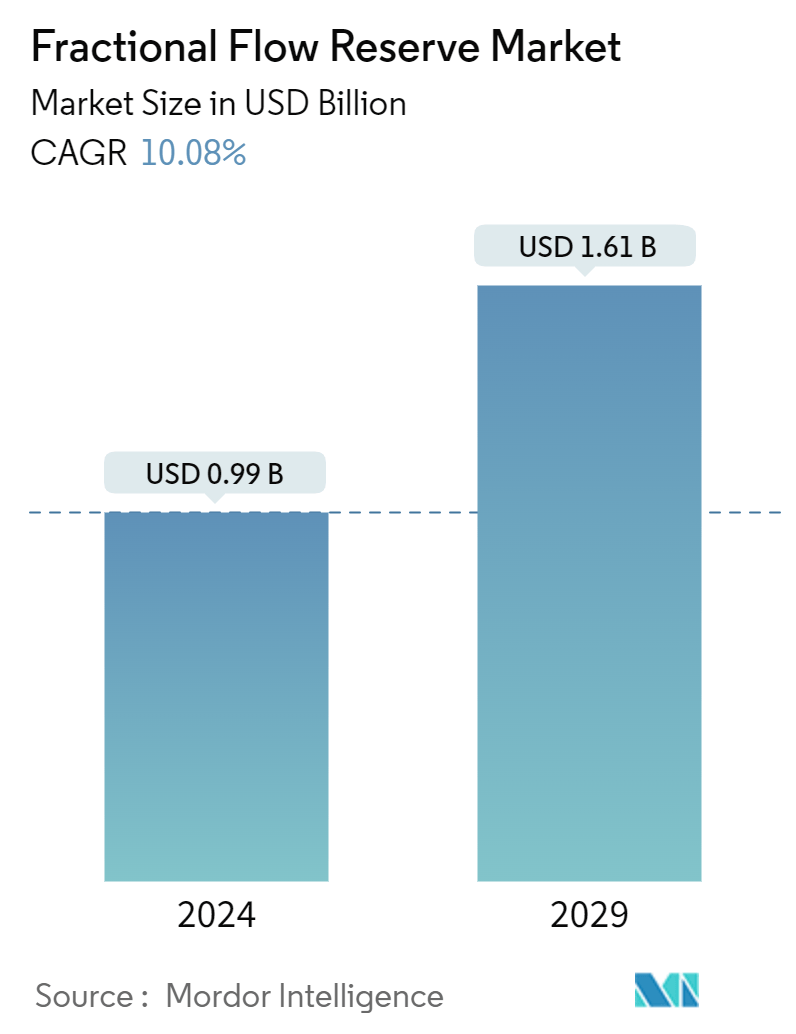Market Size of Fractional Flow Reserve Industry

| Study Period | 2019 - 2029 |
| Market Size (2024) | USD 0.99 Billion |
| Market Size (2029) | USD 1.61 Billion |
| CAGR (2024 - 2029) | 10.08 % |
| Fastest Growing Market | Asia Pacific |
| Largest Market | North America |
Major Players
*Disclaimer: Major Players sorted in no particular order |
Need a report that reflects how COVID-19 has impacted this market and its growth?
Fractional Flow Reserve Market Analysis
The Fractional Flow Reserve Market size is estimated at USD 0.99 billion in 2024, and is expected to reach USD 1.61 billion by 2029, growing at a CAGR of 10.08% during the forecast period (2024-2029).
The healthcare system had witnessed enormous challenges as a result of the COVID-19 pandemic. All outpatient treatments were postponed or restricted during the COVID-19 pandemic to reduce the risk of viral transmission, as most chronic therapies were regarded as non-urgent. It was observed that cardiovascular care delivery during the COVID-19 pandemic period was significantly reduced due to the lag in elective diagnostic testing and face-to-face patient care, as per the article published by the Radiology Cardiothoracic Imaging Society in August 2020. The fractional flow reserve (FFR) measures the ratio of the maximal myocardial blood flow in the presence of a stenosis, helping interventional cardiologists to determine the appropriate use of angioplasty and stenting. Thus, the reduction in cardiovascular services and procedures during the COVID-19 pandemic significantly affected the market's growth. However, cardiovascular patients were recommended to maintain their FFR therapy in order to improve their chances of survival and better control their immune system's capacity to resist the SARS-CoV-2 virus. Such instances bolstered the growth of the market amid the pandemic and are expected to continue the same trend over the next few years, as per the analysis.
The major factors contributing to the market's growth include the higher prevalence of cardiovascular diseases and technological advancements in FFR products.
The wide prevalence of heart diseases in the world is expected to propel the growth of the market over the forecast period. In the year 2020-21, over 14,849 people in the United Kingdom were admitted to hospitals due to heart and circulatory diseases, as per the data published by the British Heart Foundation in February 2022. Likewise, according to the CDC's article titled "Heart Disease Facts" updated in February 2022, heart disease is one of the leading causes of death in the United States. The same source also reports that every year about 659,000 Americans have a heart attack. Thus, the large prevalence of cardiovascular cases around the world creates the need for fractional flow reserves for the diagnosis of coronary artery pressure differences, in turn boosting the market growth. Furthermore, low- and middle-income countries are also witnessing an upsurge in the prevalence of cardiovascular diseases due to a lack of primary healthcare programs that offer early detection and treatment of cardiovascular disorders, according to the data published by the WHO in June 2021. Hence, the market demand for FFR products is likely to increase in these regions over the coming years.
Moreover, the increase in research on the improvisation of fractional flow reserve products is contributing to market growth. For instance, a group of researchers from the United Kingdom and Italy evaluated a clinical solution to improve the fractional flow reserve pullback for the assessment of stenosis in the event of serial disease, as per the data published by the Journal of Invasive Cardiology in July 2021. Such studies regarding the newer inventions related to fractional flow reserves are expected to significantly boost the market's growth over the forecast period.
However, the stringent regulatory framework for fractional flow reserve technologies is expected to slow down the growth of the studied market over the study period.
Fractional Flow Reserve Industry Segmentation
As per the scope of this report, fractional flow reserve is a type of procedure that is used for monitoring blood pressure flow through a specific artery. The Fractional Flow Reserve Market is segmented by Product Type (FFR System and Guidewire), Technology Type (Invasive and Non-invasive), and Geography (North America, Europe, Asia-Pacific, Middle East and Africa, and South America). The Market report also covers the estimated market sizes and trends of 17 countries across major regions globally. The report offers the value (in USD million) for the above segments.
| By Product Type | |
| FFR System | |
| Guidewire |
| By Technology | |
| Invasive | |
| Non-invasive |
| Geography | ||||||||
| ||||||||
| ||||||||
| ||||||||
| ||||||||
|
Fractional Flow Reserve Market Size Summary
The fractional flow reserve market is poised for significant growth, driven by the increasing prevalence of cardiovascular diseases and advancements in FFR technology. The market experienced challenges during the COVID-19 pandemic, as cardiovascular care delivery was reduced due to the postponement of elective procedures. However, the importance of FFR therapy for cardiovascular patients during the pandemic helped sustain market momentum. The demand for FFR products is expected to rise, particularly in regions with a high incidence of heart diseases, including low- and middle-income countries. Ongoing research and innovation in FFR technology further contribute to market expansion, despite the presence of stringent regulatory frameworks that may pose challenges.
North America is anticipated to hold a substantial share of the fractional flow reserve market, supported by a growing geriatric population and technological advancements in FFR monitoring devices. The region's high prevalence of cardiovascular conditions, coupled with an increasing number of cardiac-related surgeries, drives the demand for guidewires and other FFR products. Key market players, including Opsens Medical, Abbott, and Boston Scientific, are actively involved in strategic initiatives to enhance their product offerings, further propelling market growth. The market's fragmented nature, with several major players dominating, indicates a competitive landscape where strategic partnerships and product development are crucial for maintaining market position.
Fractional Flow Reserve Market Size - Table of Contents
-
1. MARKET DYNAMICS
-
1.1 Market Overview
-
1.2 Market Drivers
-
1.2.1 Growing Burden of Cardiovascular Diseases
-
1.2.2 Advancements in Products
-
-
1.3 Market Restraints
-
1.3.1 Stringent Regulatory Framework
-
-
1.4 Porter's Five Forces Analysis
-
1.4.1 Threat of New Entrants
-
1.4.2 Bargaining Power of Buyers/Consumers
-
1.4.3 Bargaining Power of Suppliers
-
1.4.4 Threat of Substitute Products
-
1.4.5 Intensity of Competitive Rivalry
-
-
-
2. MARKET SEGMENTATION (Market Size by Value - in USD Millions)
-
2.1 By Product Type
-
2.1.1 FFR System
-
2.1.2 Guidewire
-
-
2.2 By Technology
-
2.2.1 Invasive
-
2.2.2 Non-invasive
-
-
2.3 Geography
-
2.3.1 North America
-
2.3.1.1 United States
-
2.3.1.2 Canada
-
2.3.1.3 Mexico
-
-
2.3.2 Europe
-
2.3.2.1 Germany
-
2.3.2.2 United Kingdom
-
2.3.2.3 France
-
2.3.2.4 Italy
-
2.3.2.5 Spain
-
2.3.2.6 Rest of Europe
-
-
2.3.3 Asia-Pacific
-
2.3.3.1 China
-
2.3.3.2 Japan
-
2.3.3.3 India
-
2.3.3.4 Australia
-
2.3.3.5 South Korea
-
2.3.3.6 Rest of Asia-Pacific
-
-
2.3.4 Middle-East and Africa
-
2.3.4.1 GCC
-
2.3.4.2 South Africa
-
2.3.4.3 Rest of Middle-East and Africa
-
-
2.3.5 South America
-
2.3.5.1 Brazil
-
2.3.5.2 Argentina
-
2.3.5.3 Rest of South America
-
-
-
Fractional Flow Reserve Market Size FAQs
How big is the Fractional Flow Reserve Market?
The Fractional Flow Reserve Market size is expected to reach USD 0.99 billion in 2024 and grow at a CAGR of 10.08% to reach USD 1.61 billion by 2029.
What is the current Fractional Flow Reserve Market size?
In 2024, the Fractional Flow Reserve Market size is expected to reach USD 0.99 billion.

